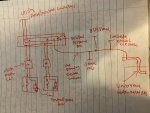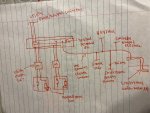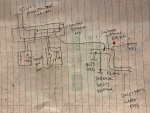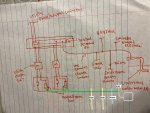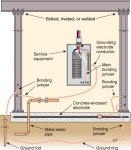hhsting
Senior Member
- Location
- Glen bunie, md, us
- Occupation
- Junior plan reviewer
Attached sketch has two service disconnect fed from wire way which is fed from one electric utility service.
The main service grounding electrode system is suppose to be per NEC 2014 section 250.64(D)(3). One grounding electrode conductor is provided which goes to underground water metal pipe electrode.
However in the sketch the same one grounding electrode has one conductor tap/joined/connected from the same one grounding electrode conductor which goes to bldg steel, one additional conductor tap/joined/connected from the same one grounding electrode conductor which goes to ground rods and one additional conductor tap/joined/connected from the same one grounding electrode conductor which goes to concrete encased electrode.
I looked into NEC 2014 250.64(C) but still confuse. I am not sure if the above tap/connection/joining from grounding electrode conductor is allowed and be in compliance with NEC 2014 Sections 250.64(D)(3) and 250.64(C)?
The main service grounding electrode system is suppose to be per NEC 2014 section 250.64(D)(3). One grounding electrode conductor is provided which goes to underground water metal pipe electrode.
However in the sketch the same one grounding electrode has one conductor tap/joined/connected from the same one grounding electrode conductor which goes to bldg steel, one additional conductor tap/joined/connected from the same one grounding electrode conductor which goes to ground rods and one additional conductor tap/joined/connected from the same one grounding electrode conductor which goes to concrete encased electrode.
I looked into NEC 2014 250.64(C) but still confuse. I am not sure if the above tap/connection/joining from grounding electrode conductor is allowed and be in compliance with NEC 2014 Sections 250.64(D)(3) and 250.64(C)?


